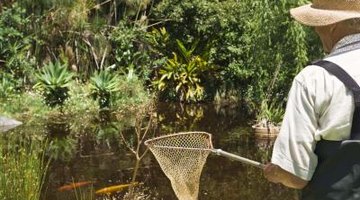How to Get Leaves Out of a Pond
The leaves of trees can easily fall into the pond. Even the leaves of trees not planted near the perimeter of the pond can easily drift into the water during a blustery day. The leaves will quickly sink to the bottom of the pond. Overtime, they break down and decay, which can produce toxins in the water. The toxins can affect the pond's fish and aquatic life community. During the winter months, the pond can sustain a sheet of ice which lowers the oxygen within the water. The problem further escalates as the leaves produce a toxic build up without adequate oxygen. The unbalanced pond ecosystem can cause fish death to occur.

Step 1
Place a net covering over the surface of the pond during the fall months. If the pond has a waterfall or stream that empties into it, cover that surface with a net, too. Weigh the net down along the perimeter of the pond using rocks.
Step 2
Remove the net every three or four days to shake off the leaves that have accumulated over its surface. Reapply the net once the leaves have been removed.
Step 3
Skim the surface of the pool using a pool skimmer to remove any floating leaves. Dip the pool skimmer into the pond's bottom to scoop out the leaves that have sank to the bottom. Discard the leaves.
Step 4
Use a pond vacuum to suck up leaves from the surface of the pond and the pond's bottom. The vacuum will also remove sludge caused by decaying leaves.
Step 5
Pump the water out of the pond. Scoop any fish from the pond using a fish net. Store the fish in a large container filled with a little water from the pond.
Step 6
Vacuum the bottom of the pond to remove all decaying leaves. Use a pond vacuum or a shop dry-and-wet vacuum. Dispose of the leaf debris.
Step 7
Refill the pond. Replace the fish.
Step 8
Clean out the pond's pump system. Remove all leaves and debris from its filtration system.
References
Resources
Writer Bio
Based in Oregon, Kimberly Sharpe has been a writer since 2006. She writes for numerous online publications. Her writing has a strong focus on home improvement, gardening, parenting, pets and travel. She has traveled extensively to such places as India and Sri Lanka to widen and enhance her writing and knowledge base.
Photo Credits
- Jupiterimages/BananaStock/Getty Images
More Articles



